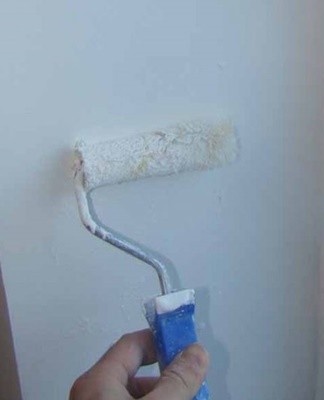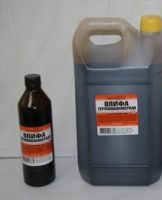Varieties and colors of paints for slopes, how to paint with your own hands
Paint for painting window slopes should not turn yellow in the sun, be resistant to moisture and wet cleaning. Openings, especially interior ones, are usually painted white. The surface of window slopes is often dirty, so it should be washed with soap and water. It is recommended to level the substrate and apply a primer before painting.
Requirements for the coloring composition
Window slopes (openings) are an important part of the structural support of windows. They are internal, external, as well as lateral, upper. The slopes of the windows are like the frame of a painting. The appearance of a room or building depends on their condition.
Internal slopes can be made of plasterboard, chipboard, plaster, paint, wallpaper pasted on the surface. Inside the building, they are sometimes made of wood, plastic, glass, mirrors. Exterior openings are most often a mixture of cement on top of the masonry, the color of which matches the shade of the facade.
For painting the slopes inside, white acrylic paint is most often used. This color was not chosen by chance.White color in interior design reflects sunlight and brightens up the room.
Painting requirements:
- decorative finish;
- UV resistance (paint materials should not yellow under sunlight);
- moisture resistance, vapor permeability;
- resistance to mechanical damage;
- coating strength;
- sustainability;
- resistance to detergents;
- non-toxic composition;
- compliance with operational requirements (weather resistance).
For exterior decoration of openings, more water-resistant compounds are used that do not pass moisture, do not crack and are resistant to temperature fluctuations. For painting exterior slopes, weather-resistant paint materials are chosen that can withstand adverse weather conditions.
Suitable varieties
For painting external or internal slopes, paint and varnish materials are selected that not only create a decorative coating, but also meet operational requirements.

For interior decoration
The following paint materials can be used to paint interior slopes:
- acrylic water dispersion (after application it dries quickly, the coating is breathable, resistant to ultraviolet rays, moisture and detergents, but careful preparation of the surface is necessary before painting);
- oil (gives a moisture-resistant and glossy coating, washes off well, but the paint itself has an odor, over time the film on the surface cracks);
- water-based acrylic emulsion (non-toxic, odorless, dries quickly, forms an abrasion-resistant coating, but does not tolerate frequent wet cleaning);
- alkyd enamel (the moisture-resistant coating can withstand frequent washing, heating up to 90 degrees, but the paint itself has a fire-hazardous composition and a pungent smell);
- acrylate (the coating is resistant to moisture, withstands frequent washing, but paint materials are expensive);
- latex (after painting it dries quickly, forms a coating that is resistant to wet cleaning, repels dirt, has a glossy or matte shine);
- silicone (waterproof, vapor permeable, lightfast, but has a high price).
For outdoor work
For painting the outer slopes, the following paint materials are used:
- solvent-based acrylic (dries quickly, forms a moisture-resistant, vapor-permeable coating that withstands adverse weather conditions, but does not withstand too low temperatures);
- epoxy (moisture-resistant, weather-resistant, durable, but has a pungent smell);
- alkyd (coating resistant to moisture, temperature fluctuations, but paint and varnish have a pungent smell, toxic composition);
- silicate (strong, waterproof, weatherproof, durable, but difficult to disassemble).

Do-it-yourself dye
Painting exterior or interior slopes won't take long. The main thing is to choose the right paint and varnish material. Particular attention should be paid to the color of the paint. When painting exterior openings, the shade should match or be in harmony with the facade. For interior slopes, it is recommended to choose a glossy or matte white paint.
If inside the building the window openings are made of wood, you can use transparent varnishes, tinted impregnations or paint materials of light colors.
Preparation of tools and materials
To paint the slopes, you will need:
- respirator, rubber gloves, goggles;
- foam roller and brushes with synthetic bristles (for water-based paints and varnishes);
- short-haired rollers and natural brushes (for solvent-based paints and varnishes);
- bath, plastic container;
- solvent for removing stains;
- sponges, rags;
- masking tape for gluing frames;
- cement mortar or putty, gypsum plaster for leveling the surface (if necessary);
- putty knife;
- painting knife to remove remnants of polyurethane foam;
- matched to paint color and performance requirements.
Surface preparation
It is recommended to carefully prepare the surface of the slopes before painting. The paint is applied on a dry, uniform, smooth and non-flaking base. At the joints of the frames, it is necessary to remove the protruding remnants of the polyurethane foam, then apply two layers of putty. It is advisable to clean the openings of the side windows from the old layer of paint materials using special solutions for removing the coating, a scraper, a spatula or a wire brush. Internal slopes can be leveled with gypsum plaster or starting and finishing putty, external - with cement mortar. Leveling is carried out if irregularities and bumps are found, using spatulas, as well as rasps and trowels to grout and sand the surface. Small cracks, cracks can be simply filled with a special putty. It is recommended to prime the surface before painting. The composition of the primer should correspond to the type of base and type of paint.

Before you start painting the slopes, you need to protect the windows from accidental knocks with paint.It is recommended that frames and glass be glued with tape or regular paper strips using regular soap instead of glue.
How to paint correctly
Painting window slopes requires care and consistency in painting. The entire surface of the openings must be completely painted. Before applying paint materials to the slope of the window, you need to mix the composition well, add, if necessary, water or solvent. Manufacturers list the type of thinner that can be used to reduce paint viscosity in the instructions or on the label.
drywall
The surface of the plasterboard is not leveled before painting, but only putty with a thin layer of finishing putty, fill the cracks, grind with an abrasive mesh and prime. The main thing is that the window opening should be completely dry before painting.First, paint the corners, seams and the surface near the frames with a brush. Large window openings can be roller painted.
The main thing is not to collect too much paint, so that it does not splash on the glass and does not flow. You must work quickly. The paint is applied from top to bottom in narrow strips (near the frames) or wide strips (on the openings). It is recommended to paint the window slopes in 2-3 layers. The interval between coats must be respected. It is recommended to wait at least 5 hours for the paint to dry completely before applying the next coat.
Plaster
After the primer has dried, the smooth interior plaster or putty surface can be painted with a paint suitable for plastering.Usually, a moisture-resistant, vapor-permeable acrylic dispersion is used for painting. It is the most economical type of painting materials. The paint is easy to use and dries quickly. A new layer can be applied after 2-3 hours.

The acrylic dispersion is non-toxic and odorless. First, the corners, seams are painted with a brush, then they are rolled over wide window openings with a roller. Slopes are painted from top to bottom with vertical stripes in 2-3 layers.
Common Mistakes
List of errors allowed when painting slopes:
- a new layer of paint materials is applied to the old, crumbling coating, as a result of which the fresh paint quickly crumbles and cracks;
- paint over an uneven surface with visible defects (paint cannot hide irregularities);
- greasy stains are not cleaned with a solvent before painting (oil stains show through on a new coating);
- do not use primer (paint consumption increases);
- apply paint materials in different directions (after drying, all randomly applied smears appear);
- paint in one layer (the surface is painted unevenly);
- Painting materials are applied to a wet surface (the paint begins to swell, bubble);
- the slopes are painted in the heat, in the summer heat (the paint does not have time to spread, it dries quickly, no scratches from the roller or brush remain on the surface).
Additional tips and tricks
Some important nuances to remember when painting slopes:
- for better adhesion of paint materials to the surface, you need to use a primer;
- it is advisable to paint the window openings with wide vertical stripes;
- for kitchen slopes, you can buy matte paint (oil stains will be visible on the glossy surface);
- the paint is applied in 2-3 layers, it is forbidden to paint the wet surface;
- for painting the slopes it is not recommended to use bituminous painting materials;
- for drywall it is better to use water-based compositions;
- acrylic dispersions are suitable for plaster walls.



